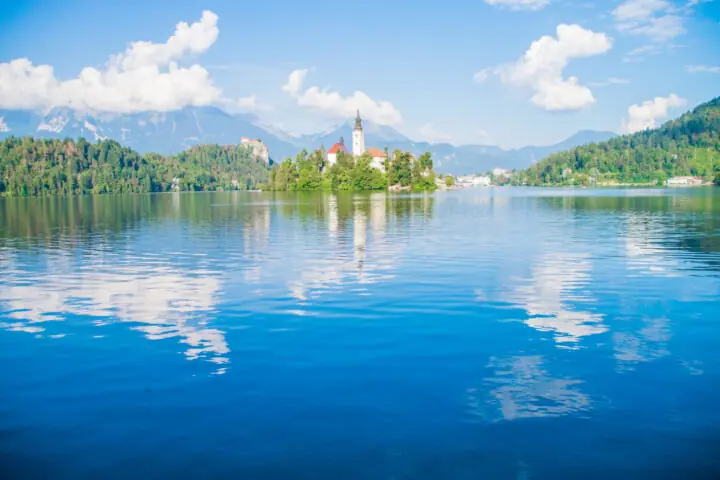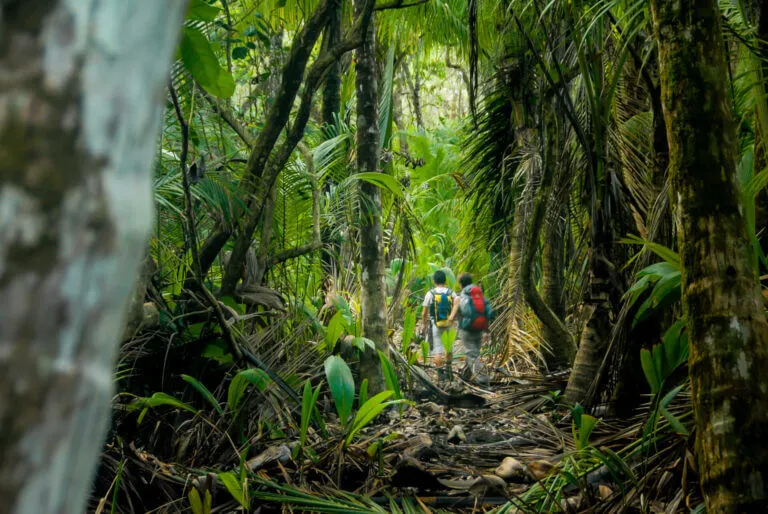10 Sustainable Tourism Destinations Ecotourists Will Love
Looking for some of the most sustainable tourism destinations that you can travel to (more or less) guilt-free? There are plenty of places to travel that place a large emphasis on sustainability and ecotourism, so you don’t have to worry as much.
Traveling is a huge part of many peoples’ lives and the world’s economy. Nothing is more exciting than exploring a new place, learning about different cultures, and meeting people with the same passion for travel. However, the tourism industry has a role in climate change – 8% of carbon emissions are from the tourism sector.
After the pandemic and lockdowns, eco-tourism became a popular talking point among globetrotters who want to lower their carbon footprint and help the environment while still seeing the world. Sustainable travel acknowledges the good and bad sides of tourism and does its best to offer the best option for visitors.
So, if you are interested in traveling more sustainably, here are some suggestions for sustainable travel destinations.
Contents
What is Sustainable Tourism?
Sustainable tourism is a form of tourism focused on minimizing the impact of travel on the environment and the cultural heritage of a location. While it was somewhat unknown before the pandemic, more and more tourists are embracing this form of travel and highlighting its importance. Today’s travelers want to be informed about eco-friendly accommodations and ways to lower pollution and be mindful of local communities. There are many ways to travel more sustainably, too!
Of course, you, as a traveler, should respect nature and keep the environment clean wherever you are. Besides protecting the environment, you should ensure your online security when you travel, too. The best way to do this is to remember to activate your antivirus software and VPN wherever you are, especially if you plan on using public Wi-Fi networks while on the move.
What is VPN? It offers powerful encryption that will hide all the data you send or receive. It means that even if you are using an unsafe connection, cybercriminals can’t get their hands on your sensitive information. This way you can keep yourself, your data, and your favorite destinations safe.
Top Sustainable Tourism Destinations
Here are ten of the best sustainable tourism destinations in the world, and why they are doing more than their part to keep ecotourism alive.
1. Slovenia

Subscribe to Adventures & Sunsets!
Each month I send out an update with the month’s most fascinating content, best travel deals and products, fun facts, best photos, and where we’ve been. Join me!OKAY I’M IN!I consent to receiving emails and personalized ads.
Slovenia is still somehow a hidden gem of Europe because not many tourists visit this place compared to other countries on the Old Continent. But that doesn’t mean Slovenia has nothing to offer. On the contrary, this country is known for its untouched nature, adorable coastal towns, and the Alps. Not to forget the picturesque Lake Bled, which is often seen on social media, and the nearby Lake Bohinj (both of which I mention in my Slovenia Itinerary).
Most importantly, Slovenia is fully committed to sustainable travel. Slovenia Tourist Board has launched a program that rates various tourist places nationwide to see if they meet the Green Destinations Standard criteria. After the verification process, tourist organizations get a Green Label which places can actually display.
Sustainability is seen in Ljubljana, the capital of Slovenia, too. The city is very walkable, with several car-free areas, an advanced garbage separation system, and lots of energy created from hydroelectric dams. There is no lack of green spaces in the urban area itself. From tree-lined avenues to large parks, visitors are encouraged to explore these places and spend time in nature.
Slovenia’s efforts in sustainable tourism haven’t gone unnoticed. European Union crowned Ljubljana as Europe’s Greenest Capital in 2016. In 2017, Slovenia became the World’s Most Sustainable Country, according to National Geographic.
2. Costa Rica

Costa Rica is fully dedicated to sustainability, which is reflected in tourism in this country. Every citizen is on board when it comes to preserving the natural environment. Extraordinary biodiversity, breathtaking beaches, and rainforests are just a few reasons tourists flock to this Central American country.
Sustainable travel in Costa Rica is made easy with the help of certifications. The grading system inspires businesses to compete with each other and improve sustainability. Certifications are regularly reviewed so travelers can be sure that the ranking score is recent.
Those of you who decide to visit Costa Rica can quickly determine which businesses and locations have the highest grade and then plan your trip accordingly. Check out some unique things to do in Costa Rica and also some stunning unique places to stay, too.
And what makes Costa Rica the top sustainable country in the world? For instance, almost all electricity in Costa Rica is generated from renewable resources. The government is doing its best to preserve nature in this part of the globe, so 25% of the territory is protected by the National System of Conservation Areas. The United Nations named Costa Rica the Champion of the Earth because of its position on saving the environment and diligently fighting climate change in 2019.
3. New Zealand
New Zealand was among the first countries to embrace sustainable tourism, and it continues to lead the way even now. The local communities are on board with preserving the country’s nature and promoting sustainable tourism through various official organizations. The perfect example is the partnerships with tourism businesses of all sizes that aim to improve sustainability on all levels.
Finding accommodation that is fully committed to sustainability is not difficult in this country. The tourist industry encourages businesses to minimize water consumption and adopt clean energy. New Zealand is all about renewable energy sources, one of the pillars of sustainable travel.
Visitors are encouraged to explore New Zealand through eco-friendly activities like hiking and wildlife observation. Since New Zealand is known for a wide range of landscapes and national parks, you can immerse yourself in different landscapes, from the mountainous South Island to the volcanic north Island.
Check out a trip to Milford Sound on the south island while visiting Queenstown, or hike to some beautiful glaciers and mountain peaks. Additionally, getting to know the indigenous culture of New Zealand is another great way to learn about this land from a different point of view; the North Island and, specifically, Rotorua are great for this.
4. Bhutan
Bhutan, the Land of the Thunder Dragon, is one of the places that has a tourist tariff, meaning that the tourist organizations always know the exact number of visitors to the country. Plus, they have a limit on the number of people that visit yearly. The government is dedicated to preserving the cultural heritage of this South Asian country as well as the landscapes, and tourists are asked to respect the traditions of the local communities.
It contributes to the unique traveling experience and makes Bhutan attractive to everyone who wants to see this mountainous country. Since Bhutan has a unique ecosystem, national parks and wildlife areas are open to visitors all year round. In 2018, Bhutan received the Earth Award for being the world’s most sustainable destination.
5. Australia
Often referred to as the leading country in eco-tourism, Australia’s governing body is aware of its natural beauty and is doing everything to protect biodiversity. Australia’s tourism industry has launched a couple of certifications, namely Green Globe and EarthCheck. These are crucial for helping tourists with finding eco-friendly accommodations and establishments.
Visitors can spend time in many stunning Australian national parks and protected areas, or dive deeper into learning about the Indigenous cultures of the continent. Additionally, bigger Australian cities, such as Melbourne and Sydney, use electric buses and trams for public transportation. This change has already improved the quality of air in urban areas and reduced pollution.
Byron Bay even has a Solar Train entirely powered by solar energy, and there are many initiatives for homes and businesses to switch to solar.
6. Sweden
Pretty much all the Scandinavian countries rank very highly among the top sustainable tourism destinations. Sweden adopted a similar program to Australia’s certificate system; local tourist organizations embraced the Nature’s Best certificate quickly. It is applied even now to rank eco-friendly establishments in Sweden. Tourists have been using this certificate since 2002, and it is irreplaceable to those who want to explore Sweden sustainably.
Considering the size and location of Sweden, it is no wonder that outdoor enthusiasts flock to this Scandinavian country. It is one of the best sustainable tourism destinations if you want to experience nature the way you want. Sweden has the Right of Public Access, or Allemansrätten, that allows everyone to explore its countryside and engage in various activities as long as you respect animals and nature.
7. Chile + Patagonia
From the stunning Patagonia to the Andes and Atacama, Chile is the perfect place for those interested in sustainable tourism and ecotourism. The government knows they must protect these natural wonders, so a Sello S certificate was introduced to encourage more businesses to become eco-friendly. Additionally, the tourism industry is working hand in hand with the governing bodies on reducing the country’s carbon footprint.
If you plan to visit Chile, engage in some exciting outdoor activities, such as skiing and kayaking, or check out my 2 week Patagonia itinerary or guide to the sights in Atacama. Many eco-friendly tour operators will help you stay safe while in nature and teach you to be mindful of nature from the north to the south, and a lot of the travel activities here don’t leave a footprint.
8. Ecuador + Galapagos Islands
Since 2015, Ecuador has been actively working on improving sustainable tourism. The Galápagos Islands, a UNESCO World Heritage site, have been protected for decades by the government to save biodiversity. While the number of tourists allowed to visit the islands is limited, you can still see other stunning locations in this country, such as the Amazon Rainforest.
Finding eco-friendly accommodations in Ecuador is not difficult since many businesses prioritize waste reduction and energy conservation. Furthermore, visitors are welcome to get to know Indigenous communities and even spend time with them to learn more about the cultural heritage of this South American country.
9. Scotland
Scotland has always been committed to preserving wilderness and conserving wildlife and nature, but they went a step up in 2020 when they were the first to sign the Tourism Declares a Climate Emergency initiative for tourism organizations to push more sustainability.
There are multiple initiatives throughout Scotland not only to preserve wilderness, but to ‘rewild’ it and keep it that way. Wilderness Scotland and Alladale Wilderness reserve have conserved tens of thousands of acres – and counting!
Tourists in Scotland are encouraged to get off the beaten path and experience nature as it was intended to be. To make sure to find the most sustainable businesses and accommodation providers to support while traveling there, see Scotland’s Green Tourism Certification Scheme.
10. Iceland
While Iceland is not a large country, all the residents seem interested in sustainability and preserving nature. The government is concerned about climate change and has already launched initiatives to cut carbon emissions by 55% by 2030, which is a significant step forward. The Icelandic Tourist Board uses Vakinn certification to help visitors find sustainable businesses and accommodation.
The extraordinary nature of Iceland and the friendly locals draw in people from all sides. While you are free to explore the country on your own, consider booking an eco-friendly tour and see all the major locations with the help of a tour guide. You will learn about the geodiversity of Iceland, the local culture and how they make the vast majority of their power via renewable energy.
